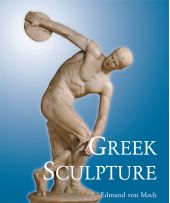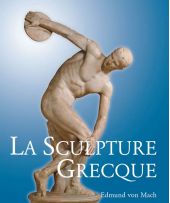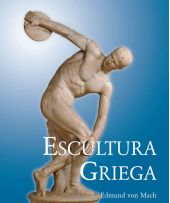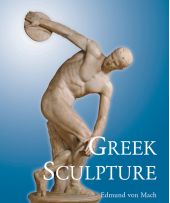Рейтинг книг Edmund von Mach
Начиная изучать творчество писателя - уделите внимание произведениям, которые находятся на вершине этого рейтинга. Смело нажимайте на стрелочки - вверх и вниз, если считаете, что какое-то произведение должно находиться выше или ниже в списке. В результате общих усилий, в том числе, на основании ваших оценок мы и получим самый адекватный рейтинг книг Edmund von Mach.
-
1.
 Greek Sculpture is probably the most well known aspect of Greek art, for a contemporary it expresses the most beautiful ideal and plastic perfection. It is the first of the Ancient Arts that looked to free itself from the imitative constraints, of the faithful representation of nature. Only a small part of the production of Greek Sculpture is known to us. Many of the masterpieces described by Antique literature are henceforth lost or badly damaged, and a large part, we know are copies, more or less skillful and faithful to the Roman era. Many have been restored by Western Sculptors, from the Renaissance to nowadays, and often in a meaning very different from the original work: a discobolous is thus turned into a dying gladiator, this god received the attributes of another, the legs of this statue are transplanted to the torso of this other one. “The soul of Greek Sculpture contains in it all sculpture. Its essential simplicity, defies all definition. We can feel it, but we can not express it. ‘Open your eyes, study the statues, look, reflect and look again,’ is the perpetual perception of anyone who wants to learn or know about Greek Sculpture.” ... Далее
Greek Sculpture is probably the most well known aspect of Greek art, for a contemporary it expresses the most beautiful ideal and plastic perfection. It is the first of the Ancient Arts that looked to free itself from the imitative constraints, of the faithful representation of nature. Only a small part of the production of Greek Sculpture is known to us. Many of the masterpieces described by Antique literature are henceforth lost or badly damaged, and a large part, we know are copies, more or less skillful and faithful to the Roman era. Many have been restored by Western Sculptors, from the Renaissance to nowadays, and often in a meaning very different from the original work: a discobolous is thus turned into a dying gladiator, this god received the attributes of another, the legs of this statue are transplanted to the torso of this other one. “The soul of Greek Sculpture contains in it all sculpture. Its essential simplicity, defies all definition. We can feel it, but we can not express it. ‘Open your eyes, study the statues, look, reflect and look again,’ is the perpetual perception of anyone who wants to learn or know about Greek Sculpture.” ... Далее -
2.
 Si l’âme est chrétienne, la beauté est grecque. Freud définit l’esthétisme comme une construction intellectuelle de paramètres personnels qui s’exprime en émotions sublimées. Avec la sculpture grecque, l’homme devient dieu, et les dieux font don de leur apparence à l’humanité. Défiant les lois de la gravité, les sculpteurs grecs découvrent les fragiles équilibres des formes, des espaces, et façonnent depuis plus de 2000 ans notre subconscient aux canons de l’éternelle beauté. Edmund von Mach, historien de l’art, revient sur cette épopée qui conduit la main de l’homme à transformer le marbre en oeuvre d’art, et l’Art en besoin substantiel de la pérennité des civilisations. Cet ouvrage étudie la sculpture grecque entre le VIIe et le Ier siècle avant J.-C., en s’appuyant sur une riche iconographie, mise en scène sur un texte érudit mais accessible à tous. ... Далее
Si l’âme est chrétienne, la beauté est grecque. Freud définit l’esthétisme comme une construction intellectuelle de paramètres personnels qui s’exprime en émotions sublimées. Avec la sculpture grecque, l’homme devient dieu, et les dieux font don de leur apparence à l’humanité. Défiant les lois de la gravité, les sculpteurs grecs découvrent les fragiles équilibres des formes, des espaces, et façonnent depuis plus de 2000 ans notre subconscient aux canons de l’éternelle beauté. Edmund von Mach, historien de l’art, revient sur cette épopée qui conduit la main de l’homme à transformer le marbre en oeuvre d’art, et l’Art en besoin substantiel de la pérennité des civilisations. Cet ouvrage étudie la sculpture grecque entre le VIIe et le Ier siècle avant J.-C., en s’appuyant sur une riche iconographie, mise en scène sur un texte érudit mais accessible à tous. ... Далее -
3.
 La escultura griega es, probablemente, el aspecto más conocido del arte griego. Para un contemporáneo, expresa el ideal de la belleza y de la perfección plástica. Es la primera de las artes clásicas que trató de liberarse de las restricciones imitativas, de la representación precisa de la naturaleza. Solo se conoce una mínima parte de la producción escultórica de la Grecia antigua. Muchas de las obras maestras que se describen en las obras de literatura clásica se han perdido o han sufrido daños considerables, y la mayoría de las piezas que conocemos son copias más o menos hábiles y fidedignas efectuadas durante la época romana. Desde el Renacimiento hasta la actualidad, muchas obras han sido restauradas por escultores occidentales, que, con frecuencia, las han interpretado de una forma muy diferente a su planteamiento original. De este modo, el discóbolo se convierte en un gladiador moribundo, un dios recibe los atributos de otro y las piernas de una estatua se implantan en el torso de otra. «El alma de la escultura griega abarca toda la escultura. Su simplicidad esencial desafía cualquier definición. Podemos sentirla, pero no podemos expresarla. “Abre los ojos, estudia las estatuas; mira, reflexiona y vuelve a mirar” debe ser el precepto continuo de todo aquel que quiera aprender o conocer la escultura griega». ... Далее
La escultura griega es, probablemente, el aspecto más conocido del arte griego. Para un contemporáneo, expresa el ideal de la belleza y de la perfección plástica. Es la primera de las artes clásicas que trató de liberarse de las restricciones imitativas, de la representación precisa de la naturaleza. Solo se conoce una mínima parte de la producción escultórica de la Grecia antigua. Muchas de las obras maestras que se describen en las obras de literatura clásica se han perdido o han sufrido daños considerables, y la mayoría de las piezas que conocemos son copias más o menos hábiles y fidedignas efectuadas durante la época romana. Desde el Renacimiento hasta la actualidad, muchas obras han sido restauradas por escultores occidentales, que, con frecuencia, las han interpretado de una forma muy diferente a su planteamiento original. De este modo, el discóbolo se convierte en un gladiador moribundo, un dios recibe los atributos de otro y las piernas de una estatua se implantan en el torso de otra. «El alma de la escultura griega abarca toda la escultura. Su simplicidad esencial desafía cualquier definición. Podemos sentirla, pero no podemos expresarla. “Abre los ojos, estudia las estatuas; mira, reflexiona y vuelve a mirar” debe ser el precepto continuo de todo aquel que quiera aprender o conocer la escultura griega». ... Далее -
4.
 Greek Sculpture is probably the most well known aspect of Greek art, for a contemporary it expresses the most beautiful ideal and plastic perfection. It is the first of the Ancient Arts that looked to free itself from the imitative constraints, of the faithful representation of nature. Only a small part of the production of Greek Sculpture is known to us. Many of the masterpieces described by Antique literature are henceforth lost or badly damaged, and a large part, we know are copies, more or less skillful and faithful to the Roman era. Many have been restored by Western Sculptors, from the Renaissance to nowadays, and often in a meaning very different from the original work: a discobolous is thus turned into a dying gladiator, this god received the attributes of another, the legs of this statue are transplanted to the torso of this other one. “The soul of Greek Sculpture contains in it all sculpture. Its essential simplicity, defies all definition. We can feel it, but we can not express it. ‘Open your eyes, study the statues, look, reflect and look again,’ is the perpetual perception of anyone who wants to learn or know about Greek Sculpture.” ... Далее
Greek Sculpture is probably the most well known aspect of Greek art, for a contemporary it expresses the most beautiful ideal and plastic perfection. It is the first of the Ancient Arts that looked to free itself from the imitative constraints, of the faithful representation of nature. Only a small part of the production of Greek Sculpture is known to us. Many of the masterpieces described by Antique literature are henceforth lost or badly damaged, and a large part, we know are copies, more or less skillful and faithful to the Roman era. Many have been restored by Western Sculptors, from the Renaissance to nowadays, and often in a meaning very different from the original work: a discobolous is thus turned into a dying gladiator, this god received the attributes of another, the legs of this statue are transplanted to the torso of this other one. “The soul of Greek Sculpture contains in it all sculpture. Its essential simplicity, defies all definition. We can feel it, but we can not express it. ‘Open your eyes, study the statues, look, reflect and look again,’ is the perpetual perception of anyone who wants to learn or know about Greek Sculpture.” ... Далее
Комментарии:


